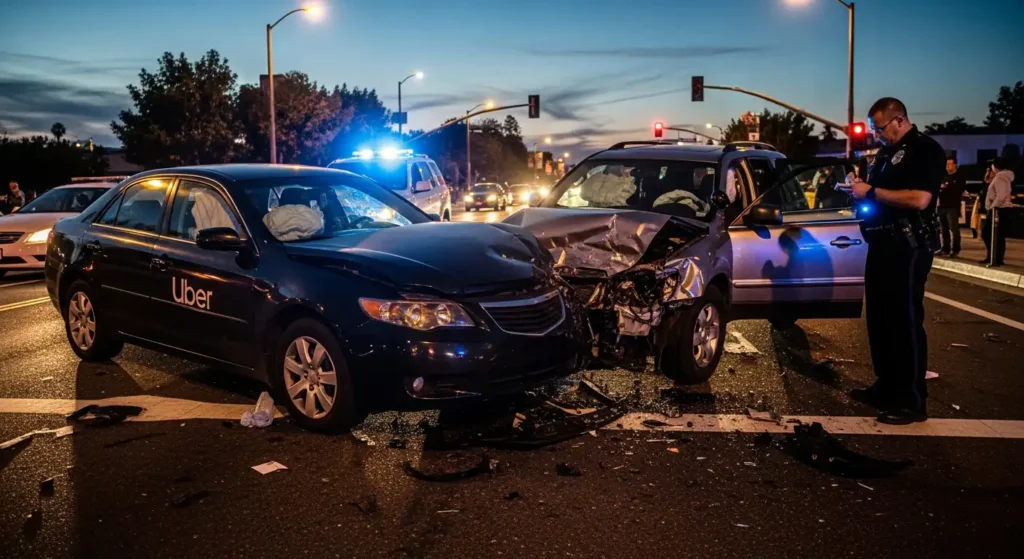Rideshare platforms like Uber have become a staple of daily transportation in 2025. With millions relying on these convenient services, accident rates involving rideshare vehicles have also seen a noticeable rise. Knowing how to properly file an Uber accident claim is critical—whether you’re a passenger, driver, or third party. Delays and mistakes can mean lost compensation or lengthy disputes with insurers.
This complete guide arms you with step-by-step instructions and practical insights for navigating the claims process after an Uber accident.
You’ll find:
- Up-to-date details on Uber’s insurance coverage
- Immediate actions to take following an accident
- Guidance for reporting and documenting your claim
- Legal considerations specific to your state
The information here helps ensure that if the unexpected happens during your ride, you’re prepared to secure the compensation you deserve. How to File an Uber Accident Claim in 2025: A Complete Guide simplifies complex procedures so you can move forward with confidence.
Understanding Uber’s Insurance Coverage Phases
 Uber insurance coverage in 2025 operates under a tiered system that depends on the driver’s status at the time of the accident. Knowing which phase applies is critical for your claim.
Uber insurance coverage in 2025 operates under a tiered system that depends on the driver’s status at the time of the accident. Knowing which phase applies is critical for your claim.
1. Offline
When an Uber driver isn’t using the app, only their personal auto insurance applies. Uber provides no coverage during this phase.
2. Online, Waiting for Ride Requests
If the driver is active on the app but hasn’t accepted a ride, Uber offers limited liability coverage. Typically, this includes up to $50,000 per person for bodily injury, $100,000 per accident, and $25,000 for property damage.
3. En Route or With Passenger
Once a ride is accepted or a passenger is in the vehicle, Uber’s commercial policy kicks in. This offers up to $1 million in third-party liability and uninsured/underinsured motorist protection.
These rideshare insurance policies directly impact claim eligibility and payout limits. If you’re injured as a passenger or another party during an “en route” phase, you may access significantly more compensation than if the driver were simply waiting for requests. Understanding these distinctions ensures you know what coverage is available before filing your claim.
Immediate Steps After an Uber Accident
Responding quickly and methodically after an Uber accident protects your health and strengthens your claim. Use this post-accident checklist to minimize confusion and maximize documentation.
- Seek Medical Attention
No matter how minor injuries may appear, get checked by a medical professional. Some injuries surface hours or days later, and medical records become crucial evidence in any Uber accident report.
- Report the Accident to Police
Request law enforcement at the scene. An official police report documents facts, clarifies responsibility, and serves as a key record for insurance and legal proceedings.
- Collect Evidence on Scene
- Take photos and videos of vehicle damage, road conditions, traffic signals, license plates, and visible injuries.
- Request contact information from all drivers involved, as well as passengers and witnesses.
- Document your own injuries with timestamped photos and brief written notes about pain or symptoms.
Following these immediate steps positions you for a stronger claim process—whether dealing with Uber’s insurance or another party.
Reporting the Accident to Uber
Promptly reporting an Uber accident is a critical step in starting your Uber claims process. The fastest way to initiate an accident report is directly through the Uber app:
- Open the Uber app and tap on “Your Trips.”
- Select the trip involved in the incident.
- Choose “Help” and then tap “Report a safety issue.”
- Follow the guided prompts to provide details, upload photos, and document injuries or damages.
Alternatively, you can reach out to Uber customer support for an accident report via their online help portal or by calling their support line. Timely notification helps protect your eligibility for compensation and ensures that Uber’s insurance team receives all necessary information to begin processing your claim without unnecessary delays.
Delays in reporting can complicate or even jeopardize your claim. Always keep records of your communications with Uber as part of your documentation for the claims process. This organized approach helps avoid confusion as you proceed with How to File an Uber Accident Claim in 2025: A Complete Guide.
Rights and Compensation for Passengers Injured in Uber Accidents
 Passengers have strong protections under rideshare insurance rules. If you’re injured as a passenger in an Uber, compensation is often available regardless of who caused the accident. Your right to file a claim isn’t limited by driver fault due to how commercial rideshare policies are designed.
Passengers have strong protections under rideshare insurance rules. If you’re injured as a passenger in an Uber, compensation is often available regardless of who caused the accident. Your right to file a claim isn’t limited by driver fault due to how commercial rideshare policies are designed.
When seeking compensation for Uber injuries, you can draw from several sources:
- Uber’s $1 Million Commercial Policy: Covers bodily injury or death when the driver is on a trip or carrying passengers.
- At-Fault Driver’s Insurance: If another motorist caused the crash, their liability policy may apply before Uber’s coverage kicks in.
- Personal Driver Policies: In some cases, both the Uber driver’s personal insurance and your own uninsured/underinsured motorist coverage can play a role.
Passenger rights in rideshare accidents mean you’re rarely left covering expenses alone. Navigating these overlapping coverages is key to maximizing your claim. Understanding where your compensation can come from helps you avoid missed opportunities when filing rideshare insurance claims.
Legal Considerations and State-Specific Regulations (Example: Missouri)
State-specific rideshare laws, such as those in Missouri, play a critical role in determining how Uber accident claims are handled. Missouri requires all rideshare drivers to carry specific liability coverage and comply with state-mandated background checks and vehicle inspections. These requirements directly impact your claim by dictating which insurance policies apply and what minimum compensation thresholds must be met. Missouri’s comparative fault rules can also influence the portion of damages you recover if multiple parties share responsibility. Staying informed about local regulations ensures your claim is filed correctly and that you access all available benefits under state rideshare regulations.
Challenges Unique to Filing Rideshare Accident Claims
Filing a rideshare accident claim comes with its own set of challenges.
Here are some of the unique difficulties you may face:
1. Determining Driver Status
One of the main challenges in rideshare claims is figuring out the driver’s status at the time of the accident. This can be tricky because disputes often arise over whether the Uber driver was logged into the app, waiting for a ride request, or actively transporting a passenger. The outcome of this determination can directly impact which insurance policy is responsible for covering damages.
2. Dealing with Multiple Insurers
Another obstacle in rideshare claims is the involvement of multiple insurers. In addition to Uber’s commercial policy, you may also have to deal with the driver’s personal insurer and possibly other drivers’ insurance companies. This complexity can make negotiations more difficult and lead to delays as each party tries to minimize its own liability.
3. Coordinating Communication and Documentation
To navigate these challenges successfully, you’ll need to be persistent and organized in your communication and documentation efforts. It’s important to keep track of all conversations, emails, and paperwork related to the claim so that you can stay on top of things and ensure that nothing falls through the cracks.
Why Consulting a Personal Injury Attorney is Crucial in Rideshare Accidents
A rideshare accident attorney can help you understand the complicated world of insurance policies and liability issues that often arise after an Uber accident. Unlike regular car accidents, rideshare accidents can involve multiple insurance companies and conflicting policies, making your claim much more difficult to navigate.
Here are some reasons why you should consider hiring a personal injury lawyer for your rideshare accident case:
- An Uber claim specialist knows how to gather evidence, assess your losses, and negotiate with insurance companies that may try to downplay or deny your claim.
- Look for legal help with rideshare accidents by searching for attorneys who have proven experience in handling Uber or Lyft cases. You can also check online reviews, professional directories, and local bar associations to verify their expertise in this specific area.
Having legal support can help you avoid costly mistakes and increase your chances of getting fair compensation for your injuries and damages caused by the accident.
Step-by-Step Guide to Filing Your Uber Accident Claim in 2025
Filing rideshare claims requires a structured approach.
Here’s a step-by-step Uber claim guide you can rely on:
- Get Medical Attention: Prioritize your health by seeking medical care, even if injuries seem minor.
- Document the Scene: Capture photos and videos of vehicle positions, damage, road conditions, and visible injuries.
- Collect Information: Obtain names, contact details, and insurance info for all drivers and witnesses present.
- File a Police Report: Request an official report, as it serves as essential documentation for your claim.
- Report to Uber: Use the app or Uber’s website to report the accident promptly—delays can impact your claim’s outcome.
Thorough documentation and timely reporting are key steps in how to file an Uber accident claim effectively.
Conclusion
Filing an Uber accident claim in 2025 requires careful attention to detail, quick action, and a clear understanding of your rights. Each step—seeking medical care, collecting evidence, reporting the incident to Uber, and tracking insurance coverage—is critical. Rideshare accident claims often involve complex insurance policies and multiple parties. This can make the process overwhelming if you try to navigate it alone.
Key tips for rideshare claims:
- Prioritize your health and safety above all else.
- Gather as much evidence as possible at the scene.
- Report the accident promptly through official Uber channels.
- Document all communication and keep copies of everything you submit.
- Be aware that insurance coverage can shift based on driver status and state regulations.
Legal support is not just helpful; it’s often essential. A qualified personal injury attorney can help you decode policy language, negotiate with insurers, and fight for fair compensation when disputes arise. You protect your interests by partnering with someone who understands the realities of rideshare claims.
For anyone searching “How to File an Uber Accident Claim in 2025: A Complete Guide,” professional legal guidance is your most effective tool for achieving a fair resolution.

